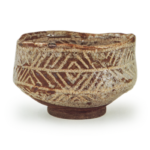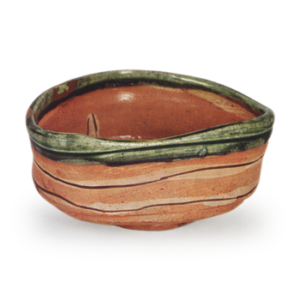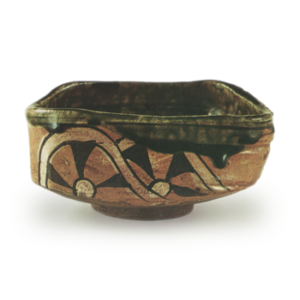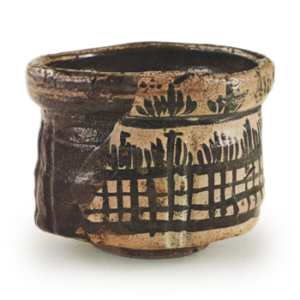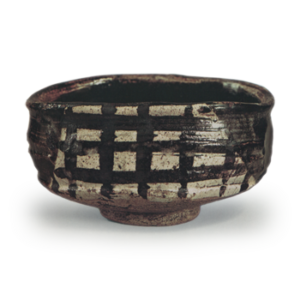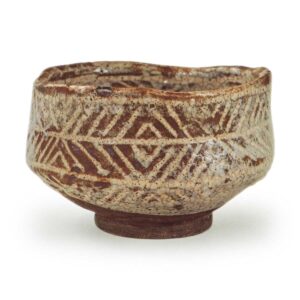
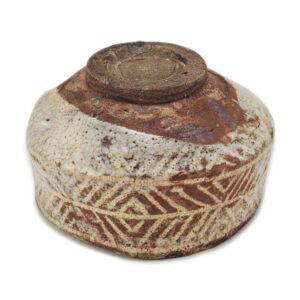
Height: 8.5cm
Diameter: 13.3-13.7cm
Outer diameter of foot ring: 6.5cm
Height of foot ring: 0.7cm
This is a rare tea bowl that imitates the carving of the Mino ware of the Koryo period using the Nezumi Shino technique. The geometric pattern of straight lines is usually called the Higaki pattern, but this is thought to be a simplified version of the original Ao-nami (blue wave) pattern. The name “Sazanami” (meaning “ripples”) given to this strongly rugged tea bowl is probably a twist of irony by the godparent, Kanamori Sowa.
The clay is covered with a full surface of wooden boards, so it is not certain, but looking at the clay around the foot, it is different from the soft finish of ordinary mugusa clay, and is hard and rough. The rough, roughly-sculpted foot is large and sits high, and the low waist is strongly pronounced, giving the tea bowl a very substantial, weighty appearance. The rim is full of changes and undulations, and the finish around the waist is strong, but the foot is particularly forceful, and the marks left by the thread cutting are still visible on the tatami mat, and the use of the spatula inside the foot is very bold.
The technique used to make this tea bowl is to first shape the white clay, which is firmer than usual, into the shape of a tea bowl using a potter’s wheel, a spatula, and the fingertips, and then to apply a thick coat of the shadow of a demon board to the entire surface. However, if it is left as it is, the foot ring will probably become dull, so in consideration of this, the thickly applied demon plate is scraped off only in the foot ring area, leaving a thin layer. In other words, the clay color that appears on the foot ring surface is covered by the thin layer of demon plate, so it appears a light grayish-brown color. The foot ring and the area next to the foot ring have a high iron content.
If you compare it with the exposed body, you can easily see the difference. Then, when the required carved lines are carved on the inside and outside of the bowl, the white of the clay appears in those areas, and by applying the white cloudy feldspar glaze unique to Shino to these areas, the carved lines become white, like inlay.
The color of the demon plate under the glaze varies subtly, depending on the shade of the demon plate itself and the thickness of the feldspar glaze, and can be seen in various ways, such as a reddish color in a grayish-brown mouse color or a bluish color. In particular, the area near the bottom of the inside of the bowl shows a beautiful contrast between the thick layers of the oni-ita and glaze, which have melted together to form a deep, dark purple-brown color, and the rough, dry exterior of the bottom, which is a major highlight of this teacup.
In addition, the white diagonal stripes cover almost the entire inside and outside of the bowl, but they are not too complicated, and their repetitive, rough composition actually serves to enhance the vividness and brightness of the design. While imitating the carved Mishima ware, the artist did not stick to the design of the blue waves, but instead freely processed the design, which can be said to have had a rather tasteful effect. In any case, this is a rare tea bowl that, while taking an unusual form in terms of design, fully demonstrates the beauty of Shino ware.
There is one repair on the rim, and there are few other scratches.
It was passed down in the Hirase family of Kyoto, and there is a paper label by Sowa on the box.

